You arrive here today to find me eating my own words. To be specific, these words – and these as well – about the lack of posters depicting the industrial North.
The cause of this is the catalogue for the new Talisman railwayana auction, which has just arrived in the post,
By far the best thing in the auction is the poster which is part shown on the cover, lot 321.
LNER quad royal pictorial Poster “East Coast Industries served by the LNER”. A dramatic image by Frank H. Mason of a blast furnace in full production. Folds, minor edge tape stains and nicks and two very small corner losses. A superb poster otherwise.
Such a superb poster that I wanted to find a proper illustration of it to post on here. I couldn’t, so this, from the catalogue, is the best I can offer.
On my travels, however, I found another one from the series in the National Railway Museum collections via the NMSI.
While this depiction of a blast furnace has been sold at various times by both Onslows and Christies.
They all date from 1938, so we have ourselves a series here.
There is a fourth one in the NRM collections, although it’s less overtly modern and mechanised than the rest.
There’s also one further poster, a kind of post-script to the series, which is this World War Two effort. It’s also by Mason and was produced just a couple of years later with a very different message, although a somewhat similar aesthetic.
From all of which, two conclusions.
The first is that there is more to Frank Mason’s work than I’ve previously given him credit for. I’ve always known he was good. but somehow never found him interesting. Those top three posters, however, really are triumphs of modernism in the most pernickety sense of the word. Mason isn’t just using a modern sttyle, he is also trying to make these industrial processes heroic and glamorous. And I think he succeeds. (Note also the almost complete absence of people in these posters, the industries are so modern that they practically run themselves. I’ll be coming back to this idea in another post one of these days.)
The second conclusion is that I was wrong about the absence of Northern industry in the visual language of railway posters. Clearly, these places and industries are represented, at least in the period between the late 1920s and World War Two. What instead has happened (as in the very similar case of World War Two posters) is that people later on have chosen not to reproduce, or buy, or sell these posters in any great number. They have in the main not been written into the later narrative. So perhaps it’s not the 1920s and 1930s I should be complaining about at all. It’s us that have chosen to forget the steelworks and the collieries and the Midland s and the North. The attitude is almost understandable now, when they’ve been eviscerated. But perhaps the forgetting was where the problem started to begin? Either that, or it’s the way in which we were persuaded that what happened to these places in the 1980s was OK.
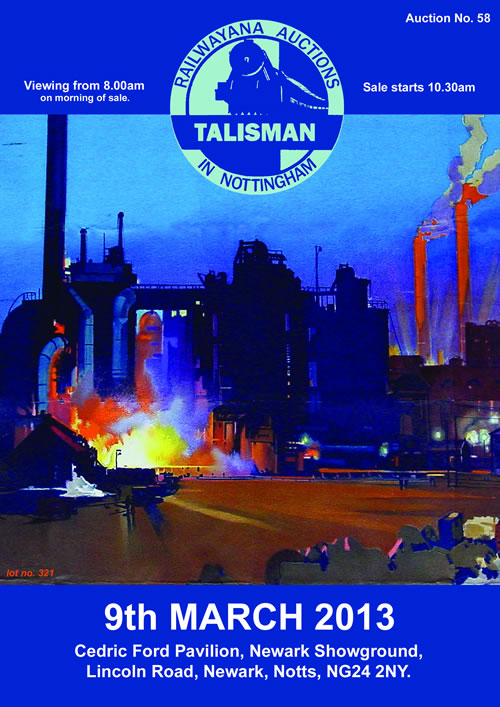
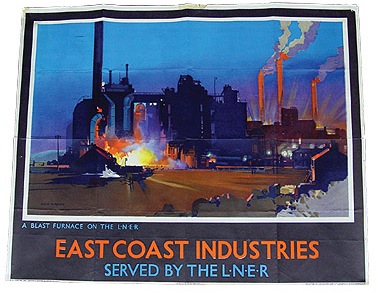
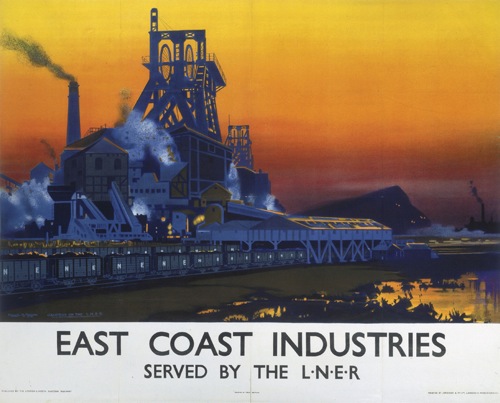

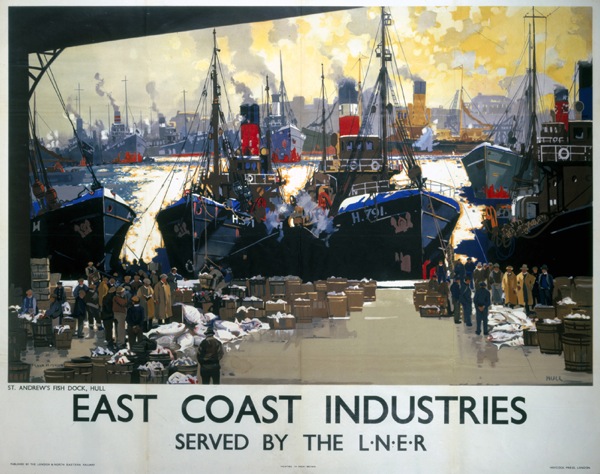
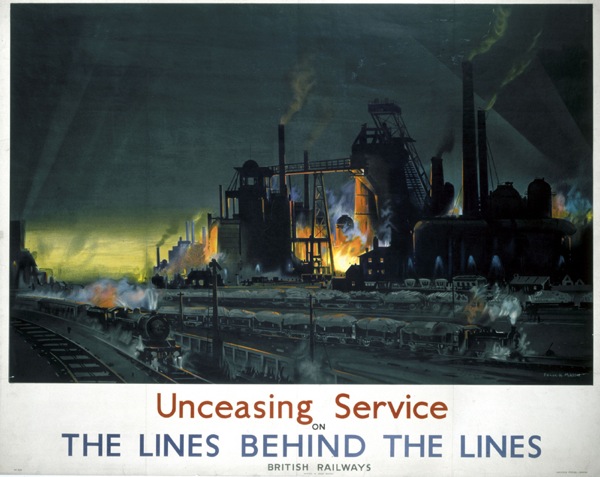
Hi… Fantastic post!..
At first glance I thought these posters may have been depicting scenes from my home town of Middlesbrough and the heavy industry at the Tees plant & docks..sadly not!.. but still evoke the very same romance and majesty of these cathedrals of industry!
As a boy, we used to take day trips by train from Middlesbrough station to Redcar or Saltburn by-the Sea just a few miles down the coast. This line used to pass at close quarters the blast furnaces & the iron & steel smelting plant at Dorman Long industries. I shall never forget the sight of the lava like molten metal being poured & extruded as the train passed by..so close, you could feel the heat coming through the windows.
These posters are very interesting to me, as although thee are plenty of reproduction travel posters of Redcar and Saltburn that are available to buy, there are none available of the areas rich industrial heritage.
The only one I have come across thats close is this one of depicting the industry at nearby Billingham. http://www.travelpostersonline.com/service-to-industry-billingham-br-vintage-travel-poster-by-terence-cuneo-996-p.asp
Many years ago, way back in the 1980s I saw an exhibition on Railway posters, & I’m sure there was an LNER poster of Middlesbrough with a scene of a large locomotive standing right next to the melting plant – the very ones I mentioned earlier…. but to this day, I’ve not been able to track it down.
The folk of Middlesbrough have a special fondness of their industrial heritage, and if this LNER poster of Middlesbrough does exist, then a reproduction would be a sure fire winner!
My last thought is that out of all the countless travel / railway posters of the various places in the UK, there seems to be a gap in the depiction of Middlesbrough?.. considering how iconic the Transporter Bridge is, I am surprised this never became a subject to be treated in a manner such as these wonderful posters.. or is there one?
Best
Sean
…I’ve just noticed that a lot of these posters were in fact printed by Jordison & Co, of Middlesbrough!.. which adds further puzzzlement to my question of the lack of a Middlesbrough train poster… however, I did come across this gem of what I think is a differnt poster of the steel mill at Dorman Long in Middlesbrough.. I think you might appreciate the technique used 🙂 http://collectionsonline.nmsi.ac.uk/detail.php?type=related&kv=230414&t=objects
The slight delay in replying is caused by me having a good look round for that picture of Middlesborough and failing to find it! And there definitely isn’t one of the Transporter bridge, an oversight that needs rectifying.
And yes, that steel one is a gem, a kind of psychedelic/modernist hybrid. And judging from the NRM catalogue, he did nothing as strange before or since, although he did have a fine penchant for very bright colours indeed. Perhaps he deserves a post one of these days.
Could this be the missing poster to which Sean refers?
http://www.bloomsburyauctions.com/detail/36040/143.0
(I pinched this link fron an old comment on this blog!)
I will poke him and ask!
Hi All, I have the Kenneth Steel North East Steelworks poster and style and colours do make it a striking piece. Sean, it was indeed printed in Middlesbrough (I got the framer to leave the printers info visible) do you have any info on which works were depicted?
As I type, a quad royal of the Billingham (my home town) Service to Industry poster is travelling up the country to its new home on my wall. I have ben waiting a long time to get my hands on one, so can’t wait 🙂
Regards, Damian
Can you send us a picture of it when it arrives? I don’t think I’m the only person who’d like to see it…